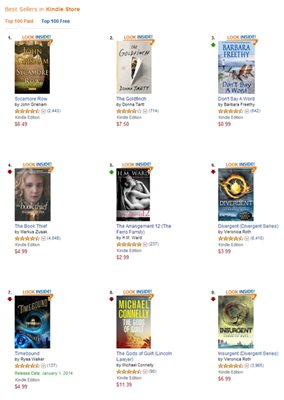Posted on 2013-Dec-11
What is a Reasonable Price Tag for an eBook?

Debunking the myth about self-publisher’s income might be nearly impossible according to the diversity of genres, subgenres, and niche markets each author has set to accomplish. Although most self-publishers share a similar goal to earn a sustainable income and maximize their book’s discoverability to make sure their target readers will continue to support their books whether in print and/or digital, can the price drop from traditional publishers pose a serious threat to indie works that mostly rely on a reasonable price tag?
Panic Alarm
Toby Neal suspects that her sales drop might have been affected by the heavy discounts of traditionally-published authors’ best-selling titles on Amazon. This issue first started in September after she received several emails that featured discounted books from authors like Janet Evanovich, Michael Connelly, Patricia Cornwell, and Donna Tartt whose books were priced at $2.99 or less.
Toby said, “My sales went to half of what they’d been. They’ve stayed at half what they’d been in spite of doing active marketing, ads on Kirkus Reviews, giveaways, promos in those same lists I get in my email inbox, and launching two new books,”.
The Digital Reader posts an insight blog from Dear Author titled “Why I think price promotions backfire?” that echoes several readers’ disappointment with inconsistent pricing strategy.
Best Sellers for $2.99! Are You Serious?

The writer of the article, Jane, exemplifies how a $0.99 price discount could pose a problem for indie authors. When Rachel Van Dyken’s first book was out, the $0.99 promotion propelled her to overnight success and that was how she got a deal with a publisher. However, the second book that was initially $2.99 and was dropped to $0.99 did not seem produce the same effect. Many commenters seem to postpone their purchasing decision since they knew they could anticipate the heavy discount after the book’s release.
Big Publishers’ Book Launch Coordination
Citing the Digital Book World’s eBook Best-Seller List as of November 21, The Digital Reader analyzes the trend and provides an interesting summary. The reason we did not get to see the fierce competition last year was because the publishers worked together to manage their release schedules. Based on Kristine Rusch’s information, traditional publishers cooperate in launching new releases that will not overlap with other big name titles through their “informal” discussions. Prior to announcing the release, they would have discussions and designate which week would be dedicated to a specific author’s book launch. For example, the week of September 24 was Stephen King week while October 22 went to John Grisham. There was only one exception: if the books were in different genres, the publishers could share the same release date since their target audience would uniquely eye the books in their favorite genre.
Fiercer Price Competition
Given the circumstance of self-publisher’s price competition, authors tend to flexibly discount prices and thus lead to higher competition based on price. Without investing in book promotion boosters like BookBub, authors may have to work harder to reach as many readers as those service providers shooting daily emails out to their subscribers’ inboxes. Nevertheless, it is interesting to observe how the best-selling titles’ prices will play out in the upcoming weeks leading to the festive seasons.
At the time of writing, the current top 20 best sellers in Kindle Store show different prices ranging from $0.99–$11.39. The median value of this price range equals $5.74, which is actually above the low price entry $2.99 as mentioned previously in this blog. Among several notable traditionally-published authors, indie powerhouses like Barbara Freethy, H.M. Ward, and Rysa Walker priced their eBooks at $0.99, $2.99, and $4.99.

$0.99 for Hoarders?

In Dear Author’s comment section, authors and readers voice their approval and disapproval of the $0.99 sweet spot. While it remains an open debate among authors which price point entry should be the most effective strategy to show readers how much the book is worth, readers are torn between canceling the preorders and waiting patiently for discounts by buying whatever price the book is set. Apart from being tied to the sweet spot allure, authors should also pay attention to building great reviews to make sure that readers can refer to credible sources before spending their money. Carmen Webster Buxton sums it up pretty accurately saying that “marketing a book is a lot like commuting – you have to do it every day.”
If $0.99 is not what the majority of commenters uniformly approves, $2.99 can be the safe bet to appeal to readers until the sales begin to fade. Earlier in May, Mark Coker also confirmed in the Smashwords survey the two sweet spots to price eBooks; eight months later, the validity of $2.99 still reigns.
2014 Pricing Strategy

Perhaps, the best practice for your pricing strategy this year is to study how price adjustments have impacted sales throughout the year. If $0.99 or $2.99 were your best promotion, analyze how long it had boosted and preserved sales. If other price alternatives gave better results, identify them and study which pricing adjustment worked best during the specific promotion period. Adding in book promotion services, how many discounted titles have you managed to sell or how many free downloads have been converted to sales? Once you figure these numbers out, you can have a rough sketch of your reader’s behavior and how they respond to your price offer. Whichever result your sales record produces, you might want to share your best strategy among your fellow indie authors and reinstate how flexible and diverse the entire industry has grown.
Label: Self-Publishing
comments powered by Disqus